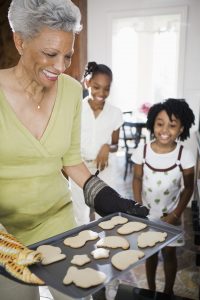
by Lisa Levine
Whether you are looking for activities, things to do, or how to engage your loved one with dementia, staying both busy and purposeful is important for all of us. All humans need a purpose, need to help others, and need to be engaged with the world around them. Having dementia makes that difficult, but not impossible.
When someone has dementia, they often have difficulty initiating tasks. This means that whether they sit in front of the TV all day or follow you around asking “What should I do now?”, they enjoy doing something. They just can’t do it on their own. You want to feel useful. So does your loved one.
Let’s explore ways to look at daily to-do’s and how we can make them work better for your person:
1. Let Go
Let go of the “this is how it should be” and embrace the “this is how it is today”. Anything we do with our person should be about the doing, not the end product. So whether it be setting the table and the silverware is in the wrong place or washing the dishes but they don’t get clean and they have to be re-washed, it’s about the doing, not the end result.
2. Go with the flow
If you start a project, task, or job and it turns into something else, go with it. If you are trying to talk about gardening and it turns into a conversation about the good old days, go with it. If your loved one is looking for their long-gone parent or family member, go with it. Empathize, “it sounds like you and your mom both love gardening, tell me more”. The facts and details don’t really matter, it’s the emotions that matter.
3. Focus on strengths
Mom used to be an excellent cook. She doesn’t talk much anymore and she can’t follow a recipe. But now I can pull out one of her old recipes and ask her to help me by chopping the nuts, stirring the batter, taste testing everything, and giving her opinion on the result.
4. Give choices
Always include choices. But limit the number of choices and be sure that all of the choices are correct. In this way we set them up for success.
• It’s time to get cleaned up, do you want to take a bath or a shower today?
• Please check the water to see if the temperature feels good.
• Do you want to wear the blue top or the green one once you get done with the (bath or shower)?
• Here is a wash cloth, do you want to wash your face or do you want me to help you?
5. K.I.S.S. – Keep is short and simple
Break things down into steps. Instead of making the bed, let’s work on taking the old sheets off first.
• Here is the pillow, will you help me take the pillow case off?
• Now let’s take off the top sheet.
• Great, let’s take the corners of the fitted sheet off the mattress.
One step at a time.
6. Slow down and turn everything into an event
Taking a shower, getting dressed, making the bed, setting the table, washing the dishes. These can all be considered “activities” or ways to engage our loved ones. If we ask for their help and opinions, really listen to what they have to say, and thank them once the task is finished, they can feel good about themselves.
7. Look for the moments of joy.
It’s often easy to say it’s been a bad day because something goes wrong. But if we focus on the little steps and appreciate the small moments, we might find it’s not that bad.
So maybe we didn’t do everything on the today’s to-do list. But maybe we did help our person take a shower, get dressed and go for a walk outside. And maybe we shared a good laugh during that time. Savor the happy.
Below you will find many links to both how to better engage your person in their day and things they might like to do. There is a lot of information. The key is to focus on your person. What do they like? What did they used to do and how can I adapt it for them to do now? And don’t beat yourself up. This is hard. Many days it’s hard enough just to take care of ourselves let alone someone else.
Remember, you’re doing the best you can, it’s good to reach out for help, you need to take a break now and then, and you need to something for yourself.
Online programming resources for caregivers of people living with dementia:
The Best Friend’s Approach to Activities is the backbone to good programs, here Health Professions Press has shared a quick list of what engaging our loved ones should include:
https://bestfriendsapproach.com/wp-content/uploads/2017/02/BF-Approach-to-Activities.pdf
What is engagement and how can it help?:
https://www.alztennessee.org/help/caregiver-support/caregiver-academy-videos/engagement
What to keep in mind as you are planning things to do:
https://www.alz.org/help-support/caregiving/daily-care/activities
This link discusses a variety of things to do to engage someone living with dementia and shares links for good online resources and content:
Activities for kids and teens to do with people living with dementia, this is a great list for everyone:
https://www.alz.org/help-support/resources/kids-teens/50-activities
Things to do based on a person’s past roles and how they see themselves:
https://www.verywellhealth.com/dementia-patients-meaningful-activity-ideas-97707
Video on how activity levels can affect sleep:
https://www.youtube.com/watch?v=p0ZXY2PZyCA
Online activity programs including music, exercise and art:
Music & Memory at Home:
https://dementianc.org/family-services-support/music-memory-at-home/
Online coloring pages:
Online puzzles and trivia games:
https://www.nccap.org/assets/docs/101%20ideas%20for%20in%20room.pdf
https://www.nccap.org/assets/docs/Spring%20Theme%20Packet.pdf
https://www.nccap.org/assets/docs/Water%20Theme%20Packet.pdf
https://www.nccap.org/assets/docs/Famous%20People%20Packet.pdf
http://freedailycrosswords.com/printable-crossword-puzzles/
http://www.alzark.org/wp-content/uploads/2015/03/Memory-Book.pdf
For a list of online virtual tours and animal cams click our COVID-19 family resources page



